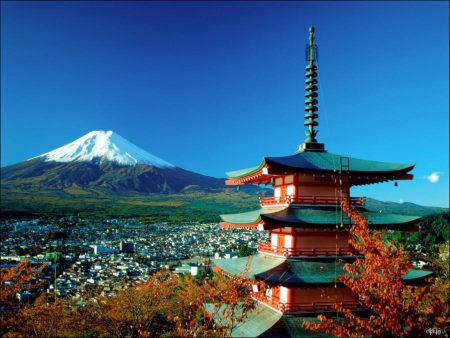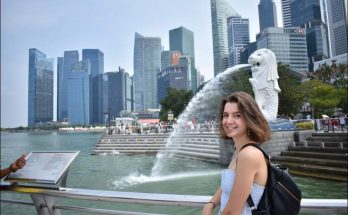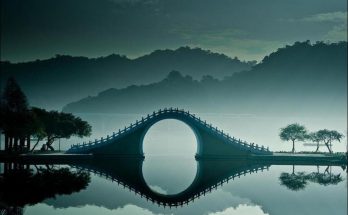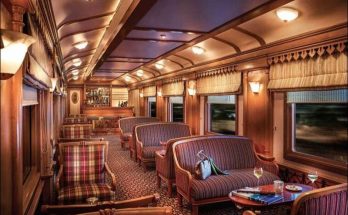From Kyoto
Thanks to its perch in the relatively high latitudes, northeast Asia is the only part of the region that enjoys four distinct seasons-a climatic oddity that makes it curiously familiar for Westerners traveling in Japan, Korea, and parts of northern China. Cherry-blossom time is perhaps the best season to visit Japan (though beware of the crowds), and fall the best for Korea (where the colors easily rival those of New England). In China’s north and Russia’s far east, high summer or midwinter are best-warm sunlit evenings in July or magnificent snowy vistas in December.
Forget Tokyo as a base: Its monstrous international airport, Narita, happens to be so inconveniently sited-at the very least, two and a half hours from the average Tokyo hotel room-that it is actually the very last place to choose. By contrast, Osaka’s handsome new airport proves a very good jumping-off point and is well connected to its neighbor cities, and not least to the exquisite old Japanese capital of Kyoto-which means that you can spend a meditative morning communing with the stones in Ryoan-ji Temple or strolling the Philosopher’s Walk from Eikan-do to Ginkaku-ji before setting out, via what is called the new Kansai airport, on your adventure.
There ate–two further practical advantages to Osaka. First, flights from the Kansai field to Tokyo land not at the far away Narita but at the much handier Haneda Airport, only minutes from Tokyo’s city center; and second, Osaka-where there is a brand-new Imperial Hotel that is well worth seeing-is nearer to the major centers of South Korea, essential destinations for anyone wanting to have the full picture of what northeast Asia is all about.
To Tokyo
This, of course, has to be the prime destination, but it is invidious to offer specific sites of pilgrimage-the Imperial Palace, the Ginza, the 5 A.M. auctions at the Tsukiji fish market. Better to suggest things to do, such as Kabuki theater (marathan sessions are held at the Kabuki-za Theater in Ginza), or No drama (at the nearby Ginza No-Gakudo), or simply the amazing nightlife in such areas as Shinjuku or Roppongi. Whereas in smaller Japanese cities and towns it’s a good idea to have the (incredibly expensive) experience of staying in a local inn, a ryokan, in Tokyo you are better advised to stay at a Western-style hotel, of which the Seiyo Ginza and the Imperial remain among the best.
To Mount Fuji
Mount Fuji and the nearby hot spring region of Hakone are well within the two-hour range for train journeys from Kyoto. You climb the mountain (in Japan they say the wise man climbs it but only the fool climbs it twice), taking about four hours up, two down; warm clothing is essential if you climb at night-as you should, in order to witness goraiko, the sunrise, from the summit.In Hakone, where you can stay at astonishingly costly hotels like the Fujiya, one ofthe oldest Western-style hotels in the country, the attractions are legion-lakes, mountains, mud baths, ancient forests, and, if you’re lucky, morning views of Fuji-san looming over all.
To Kyushu Island
Here is where you come to know Japan best of all, however, by experiencing her traditions and her curiosities rather than by seeing her cities and her sights. But doing this demands same valor on the part of the casual visitor-nowhere more so than in the sampling of the onsen, the open-air bath. Try Beppu, where you can either bathe in a variety of types and temperatures of water or be buried up to the neck in hat sand on a volcanic beach. In Yufu-in, inland and near-by, the scene is more genteel and more beautifully and classically Japanese, and there are plenty of smaIl hotels with adjoining baths.
Also on Kyushu is the reborn town of Nagasaki-famous for its role as the first open city in pre-Meiji Japan and as the second city to be devastated by the American nuclear attacks in 1945. Hiroshima, two hours by train southwest of Osaka and still on the main island of Honshu, is equally well worth visiting.The two other main islands of Japan-the small and temple-filled Shikoku and the large and largely agricultural Hokkaido-are less frequently visited. For those with time (six weeks if on foot, a day if by bus), there is a memorable pilgrimage route that takes in all 88 temple site s on Shikoku; and for those with wintertime energy, the skiing around Sapporo is excellent. The Shikotsuko Hokkai Hotel here offers one of the few affordable Japanese ryokan experiences in the country.
To Korea
From Osaka Airport, it is quick and easy to reach Seoul, Pusan, and, with a little more effort, the North Korean capital of Pyongyang. While the sight of the Cold War, still very much alive and well at the armistice village of Panmunjom, may enthrall some, the little-known countryside of South Korea remains spectacularly beautiful: The unforgettable temple of Haein-sa near the city of Taegu is among the most notable places.Within locked rooms and guarded by monks lies one of the original Buddhist woodenblock libraries, the Tripitaka Koreana, carved in the thirteenth century; and the temple itself sits in a dreamlike panorama of misty mountains of unparalleled beauty-the perfect spiritual link to the fragile loveliness of the Kyoto temples.
Visits: 89



